各种时态的主动、被动语态结构表
英语中8种时态的主动语态和被动语态
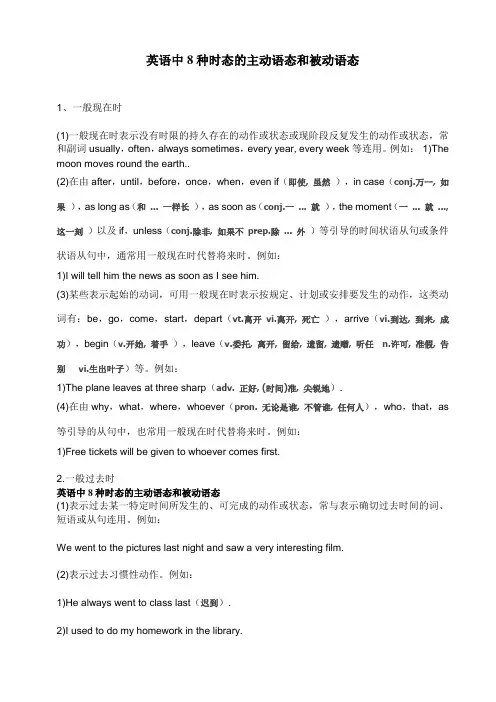
英语中8种时态的主动语态和被动语态1、一般现在时(1)一般现在时表示没有时限的持久存在的动作或状态或现阶段反复发生的动作或状态,常和副词usually,often,always sometimes,every year, every week等连用。
例如:1)The moon moves round the earth..(2)在由after,until,before,once,when,even if(即使, 虽然),in case(conj.万一, 如果),as long as(和 ... 一样长),as soon as(conj.一 ... 就),the moment(一 ... 就 ..., 这一刻)以及if,unless(conj.除非, 如果不prep.除 ... 外)等引导的时间状语从句或条件状语从句中,通常用一般现在时代替将来时。
例如:1)I will tell him the news as soon as I see him.(3)某些表示起始的动词,可用一般现在时表示按规定、计划或安排要发生的动作,这类动词有:be,go,come,start,depart(vt.离开vi.离开, 死亡),arrive(vi.到达, 到来, 成功),begin(v.开始, 着手),leave(v.委托, 离开, 留给, 遗留, 遗赠, 听任n.许可, 准假, 告别vi.生出叶子)等。
例如:1)The plane leaves at three sharp(adv. 正好, (时间)准, 尖锐地).(4)在由why,what,where,whoever(pron. 无论是谁, 不管谁, 任何人),who,that,as 等引导的从句中,也常用一般现在时代替将来时。
例如:1)Free tickets will be given to whoever comes first.2.一般过去时英语中8种时态的主动语态和被动语态(1)表示过去某一特定时间所发生的、可完成的动作或状态,常与表示确切过去时间的词、短语或从句连用。
被动语态各种时态构成表
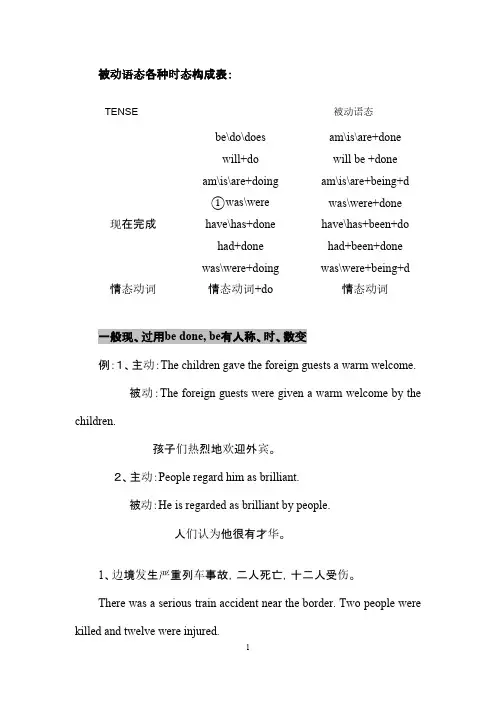
被动语态各种时态构成表:TENSE被动语态be\do\does am\is\are+donewill+do will be +doneam\is\are+doing am\is\are+being+d①was\were was\were+done现在完成have\has+done have\has+been+dohad+done had+been+donewas\were+doing was\were+being+d 情态动词情态动词+do情态动词一般现、过用be done, be有人称、时、数变例:1、主动:The children gave the foreign guests a warm welcome. 被动:The foreign guests were given a warm welcome by the children. 孩子们热烈地欢迎外宾。
2、主动:People regard him as brilliant. 被动:He is regarded as brilliant by people.人们认为他很有才华。
1、边境发生严重列车事故,二人死亡,十二人受伤。
There was a serious train accident near the border. Two people were killed and twelve were injured.2、直言不讳的人才是真正诚实的人。
A person who is truly honest is called a straight arrow.3、有人给讲演者递上来一张纸条。
A note was passed up to the speaker.4、John被选为班长而代替了亨利。
John was elected president of the class instead of Harry.5、这位战士牺牲了,然而列车得救了。
动词不定式的被动语态主动表被动
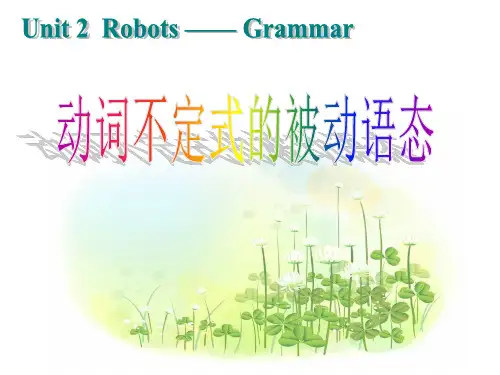
二、动词不定式的被动语态
1. 动词不定式的被动语态有两种形式:
1)一般式 (not/never )to be done
2)完成式 (not/ never) to have been done (表示不定式动作发生在谓语动词之前)
C. to choose
D. for choosing
8. ________late in the afternoon, Bob turned off the alarm.
A. To sleep C. Sleep
B. Sleeping D. Having sleep
9. With a lot of difficult problems ________,the newly-elected president is having a hard time.
3) I cannot go out now as I have a lot of clothes _t_o_w_a_s_h_____(wash)
3. 在下列情况中用不定式的主动形式表示被动意思。 2) 在“主语+表语(形容词)to do” 中, 主语也是 不定式的逻辑宾语,即不定式动词和主语之间是 动宾关系。
He hurried to the booking office only to be told that all the tickets had been sold out.
时态 语态 主动语态 一般式 to do
被动语态 to be done
完成式 进行式
to have done
27_专题十 动词的被动语态
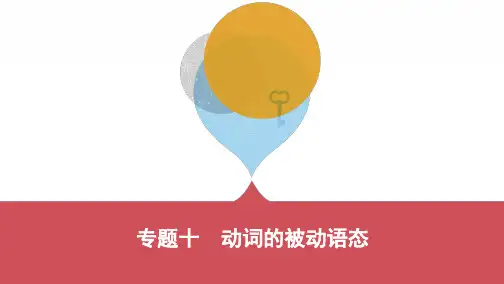
考点清单 栏目索引
4.被动语态的注意事项 (1)主动形式表达被动意义 ①open,lock,write,read,sell,clean,wash,cut,burn,drive等词作不及物动词时,它们 的主语为物,可用主动形式表被动意义。 This kind of pen writes very smoothly. 这种钢笔写起来很流畅。 This kind of shirt sells well here. 这种衬衫在这儿卖得好。
现在完成时 have/has+done
have/has+been done Jim has finished the work. The work has been finished by Jim.
will/shall/be going to+ will/shall/be going to+be They will plant trees tomor Trees will be planted by them tomo 一般将来时
We clean the classroom. The classroomis cleaned by us.
一般过去时 did
was/were+done
He made the kite.
The kite wasmade by him.
现在进行时 am/is/are+doing
am/is/are+being Done She is watering flowers. Flowers arebeing watered by her.
11、只有让学生不把全部时间都用在学习上,而留下许多自由支配的时间,他才能顺利地学习……(这)是教育过程的逻辑。21.9.623:10:2023:10Sep-216-Sep-21
各种时态的主动语态和被动语态谓语结构对照表
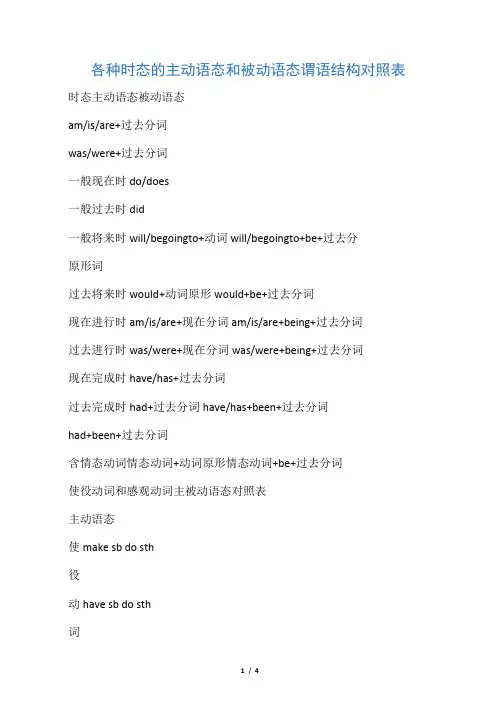
各种时态的主动语态和被动语态谓语结构对照表时态主动语态被动语态am/is/are+过去分词was/were+过去分词一般现在时do/does一般过去时did一般将来时will/begoingto+动词will/begoingto+be+过去分原形词过去将来时would+动词原形would+be+过去分词现在进行时am/is/are+现在分词am/is/are+being+过去分词过去进行时was/were+现在分词was/were+being+过去分词现在完成时have/has+过去分词过去完成时had+过去分词have/has+been+过去分词had+been+过去分词含情态动词情态动词+动词原形情态动词+be+过去分词使役动词和感观动词主被动语态对照表主动语态使make sb do sth役动have sb do sth词let sb do sthsee sb do sth感观watch sb do sth动词hear sb do sthnotice sb do sth被动语态sb be made to do sthsb be had to do sthsb be let to do sthsb be seen to do sthsb be watched to do sthsb be heard to do sthsb be noticed to do sth①Lily writes many letters every day.(主动)②Th ey visited this farm last year.(主动)③We have learned 3000 English words so far.(主动)Fill in the blanks with the Passive Voice1、Tea_______(grow) in Fujian.2、Chinese__________(speak) in China.3、The bed__________(use) for sleeping.4、Ourclassroom _________(clean) everyday.5、The cars__________(make) in Beijing.6.We will build a new lab.A new lab ____ ____ _____.(主动变被动)7. The blackboard was ________ (look) carefully by the students.8 The ship model ____ be ____ (make)in two days.1.An exhibition of paintings ____ at the museum next week.A.are to be heldB. is to be held C. are holding D.will be held2. I’m sorry,sir.Your recorder isn’t ready yet.It ____ in the factory.A.is being repairedB is repaired C. has been repaired Dhasn’t been repaired3. A lot of people in China can speak English now .(同上)English ______ ____ ______ by a lot of people in China now.4. I have learned English for about two years.(同上)English ______ ______ ______ for about two years.5. They will publish these story-books next month.(同上)These story-books _____ _____ _____ next month.6.Peoplethereplantedmanytreeslastyear.Trees__________by people there last year. (青岛市中考题)7. Theygrowvegetables on the farm.The vegetables_____________on the farm(上海市中考题)8.Our school _________in 2002.(开办)9.The young trees must____ ____ ______well.(照顾)10. _____ this building_________(建成)last year?11.The book _____ _______(写)by him last year.12. The bridge _______ _______(不建造)in1989..13.The 29th Olympic Games will____ ______(举行) in UK in 2012.14. He gives me a ring.I _____________ a ring ____ him.15. Jack made his little sister cry again.His sister _________ ____ cry again.1.被动语态练习() 1 The People's Republic of China __ on October 1, 1949.A. foundB. was foundedC. is foundedD. was found() 2 English ____ in Canada.A. speaksB. are spokenC. is speakingD. is spoken() 3 This English song___ by the girls after class.A. often singsB. often sangC. is often sangD. is often sung() 4 This kind of car ___ in Japan.A, makes B. made C. is making D. is made() 5 New computers ___ all over the world.A. is usedB. are usingC. are usedD. have used() 6 His new book___ next month.A. will be publishedB. is publishingC. is being publishedD. has been published()7 The sports meet ___ be held until next week.A. didn'tB. won'tC. isn'tD. doesn't。
动词不定式的被动语态主动表被动
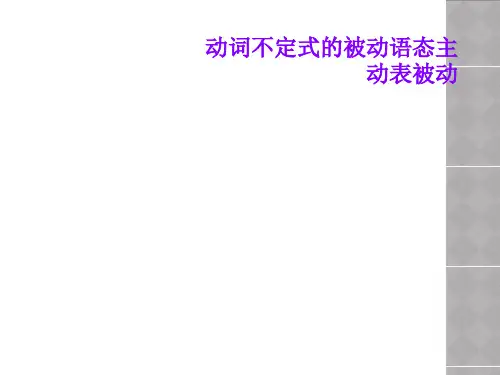
A. to invent C. to have invented
B. inventing C. having invented
4. Allen had to call a taxi because the box was _____ to carry all the way home.
A. much too heavy C. heavy too much
2. 动词不定式的被动语态在句子中的作用 1) 做主语(常用it做形式主语) To be offered sympathy by a robot is ridiculous.
It is ridiculous to be offered sympathy by …. 被邀请参加这个亚运会开幕式,是一大荣幸。
this evening.
A. to be taken C. being taken
B. to take D. taking
7.There are five pairs ___,but I’m at a loss which to buy.
A. to be chosen B. to choose from
动词不定式的被动语态主 动表被动
一、复习各种时态的被动语态
★ 被动语态的基本结构: be+ done (以 the book , publish 为例) 一般现在/过去时: The book __i_s_/_w__a_s_p_u_b_l_is_h_e_d____. 一般/过去将来时: The book ___w__il_l/_w__o_u_ld__b_e_p_u__b_li_sh_e_d___. The book ___is_/_w__a_s_g_o_in_g__t_o_b_e__p_u_b_li_s_h_e_d. 现在/过去进行时: The book ___i_s_/_w_a_s_b_e_i_n_g_p_u_b__li_sh_e_d_____. 现在/过去完成时: The book ___h_a_s_/_h_a_d__b_e_e_n_p_u_b__li_sh_e_d_____. 情态动词:
八大时态的被动语态结构
八大时态的被动语态结构
以下是八大时态的被动语态结构:
1. 现在时被动语态(Present Simple Passive):主语 + am/is/are + 过去分词。
2. 过去时被动语态(Past Simple Passive):主语 + was/were + 过去分词。
3. 将来时被动语态(Future Simple Passive):主语+ will be + 过去分词。
4. 现在进行时被动语态(Present Continuous Passive):主语 + am/is/are being + 过去分词。
5. 过去进行时被动语态(Past Continuous Passive):
主语 + was/were being + 过去分词。
6. 现在完成时被动语态(Present Perfect Passive):
主语 + has/have been + 过去分词。
7. 过去完成时被动语态(Past Perfect Passive):主语 + had been + 过去分词。
8. 将来完成时被动语态(Future Perfect Passive):主语 + will have been + 过去分词。
专题一 被 动 语 态的构成及用法
专题一被动语态的构成及用法一、被动语态被动语态的基本结构为:be+动词的过去分词(1)不知道动作的执行者是谁。
如:This watch is made in China(2)没有必要指出动作的执行者是谁。
如:More trees must be planted every year.。
(3)需要强调或突出动作的承受者时。
如:Chinese is spoken by more and more people in the world.(4)句子的主语是动作的承受者。
如:Many houses were washed away by the food.二、主动语态和被动语态的转换1.主动语态变为被动语态(1)要将主动句里的宾语变为被动句中的主语,若主动句中的宾语是人称代词,要将宾语变成主格。
(2)把主动句中的主语变为被动句中的宾语,主格变成宾格,并用by引导。
(3)谓语动词变成相应的被动形式。
主动语态:动作执行者+谓语动词主动形式+动作承受者被动语态:动作承受者+谓语动词被动形式+动作执行者如:We asked him to sing an English song.(变为被动语态) →He was asked to sing an English song by us.2.带双宾语的谓语动词变为被动语态谓语动词带双宾语时,既可以将间接宾语转化成主语,也可以将直接宾语转化为主语。
若将间接宾语转化为主语,则保留直接宾语;若将直接宾语转化为主语则保留间接宾语,且在被保留的间接宾语前加上介词to或for。
如:She gave me a book.(变为被动语态) →I was given a book by her.(间接宾语me改为了主语)A book was given to me by her.(直接宾语a book 改为了主语)3.动词短语变为被动语态许多由动词和介词、副词构成的动词短语相当于及物动词,可以有宾语,也可以有被动语态。
各种时态的主动、被动语态结构表
was/were+done
Hebought me some books.
I was bought some booksby him.
Some books were bought for me byhim.
现在进行
1)表示此时此刻或现阶段正在进行或持续的动作
now, these days等或当句中含有look, listen之类的暗示词时
am/is/are+doing
am/is/are+being+done
She is watering the flowers.
The flowers are being made by her.
过去进行
表示在过去某一时刻或过erday, at that time, then, at ten yesterday, from 7:00 to 9:00 last night
had+done
had been+done
They had told me the newsby 9 o’clock yesterday.
I had been told the news by 9 o’clock yesterday.
The news had been told to me by 9 o’clock yesterday.
was/were+doing
was/were+being+done
I wasplanting treesthis time yesterday .
Trees were being planted by me this time yesterday.
一般将来时
英语各时态的主动句和被动句
一般将来时(Simple Future):主动语态:明天我将会见我的朋友。
(I will meet my friend tomorrow.)被动语态:我的朋友将被我明天见到。
(My friend will be met by me tomorrow.)主动语态:下个月我将搬到一个新的城市。
(I will move to a new city next month.)被动语态:一个新的城市将被我下个月搬到。
(A new city will be moved to by me next month.)主动语态:明年我将开始学习弹钢琴。
(I will start learning to play the piano next year.)被动语态:学习弹钢琴将被我明年开始。
(Learning to play the piano will be started by me next year.)现在进行时(Present Continuous):主动语态:我正在看电视节目。
(I am watching a TV show.)被动语态:电视节目正在被我观看。
(A TV show is being watched by me.)主动语态:他们正在制定新的计划。
(They are making new plans.)被动语态:新的计划正在被他们制定。
(New plans are being made by them.)主动语态:我们正在等待朋友的到来。
(We are waiting for our friend's arrival.)被动语态:朋友的到来正在被我们等待。
(Our friend's arrival is being waited for by us.)现在完成时(Present Perfect):主动语态:我已经完成了我的工作报告。
(I have finished my work report.)被动语态:我的工作报告已经被我完成了。
- 1、下载文档前请自行甄别文档内容的完整性,平台不提供额外的编辑、内容补充、找答案等附加服务。
- 2、"仅部分预览"的文档,不可在线预览部分如存在完整性等问题,可反馈申请退款(可完整预览的文档不适用该条件!)。
- 3、如文档侵犯您的权益,请联系客服反馈,我们会尽快为您处理(人工客服工作时间:9:00-18:30)。
2.和for或since引导的时间状语连用.
have/has+done
have/has been+done
They have made the boystopcryingalready.
The boy has been made tostopcryingalready.
had+done
had been+done
They had told me the newsby 9 o’clock yesterday.
I had been told the news by 9 o’clock yesterday.
The news had been told to me by 9 o’clock yesterday.
am/is/are+doing
am/is/are+being+done
She is watering the flowers.
The flowers are being made by her.
过去进行
表示在过去某一时刻或过去某一阶段正在进行的动作
this time yesterday, at that time, then, at ten yesterday, from 7:00 to 9:00 last night
各种时态的主动、被动语态结构表(以动词do为例)
时态
用法
时间状语
动词构成
例句
主动语态
被动语态
主动语态
被动语态
一般现在时
1)经常性、习惯性的动作或存在的状态。2)主语的特征、性格、能力、爱好等。3)表示客观真理
often,sometimes,always,usually
everyday/……; on Mondaysonce a week,twice a year
do/does
am/is/are+done
We clean the classroom.
The classroom is cleaned by us.
一般过去时
表示在过去某个时间发生的动作或存在的状态,也表示过去经常或反复发生的动作。
yesterday;lastweek/…;in 1990
ten minutes ago பைடு நூலகம்ust now
did
was/were+done
Hebought me some books.
I was bought some booksby him.
Some books were bought for me by him.
现在进行
1)表示此时此刻或现阶段正在进行或持续的动作
now, these days等或当句中含有look, listen之类的暗示词时
打造全网一站式需求
欢迎您的下载,资料仅供参考
in a few days
in 2020
will/shall+do
am/is/are going to+do
am/is/are+doing
will/shall be+done
am/is/are going to be+done
am/is/arebeingdone
We will discuss this question in class tomorrow.
过去完成时
1)过去完成时动词表示过去某一时间或某一动作之前完成的动作或状态。
2)从过去某一时间开始持续到过去另一时间的动作或状态。
1)与by then,by 9 o’clock,by the endof,by the time…,before+过去的时间构成的短语连用。2)过去完成时和already, just, ever, yet等连用。3)与when, before, after,as soon as等引导时间状语的从句连用,强调动作发生的时间前后
was/were going to be+done
was/were being+done
He said he would finish the work the next day.
He said the work would be finished the next day.
现在完成时
1)表示过去发生的动作或事情对现在的影响和产生的结果.它强调的是过去的动作同现在的联系。2)表示一个从过去开始,一直持续到现在,有可能继续下去的动作或状态.
含有情态动词
can/may/must do
can/may/must be done
We must take good care of the old.
The old must be take good care of by us.
THANKS !!!
致力为企业和个人提供合同协议,策划案计划书,学习课件等等
This question will be discussed in class tomorrow.
过去将来时
表示从过去某一时间看将要发生的动作或存在的状态,常用在宾语从句中
would/should+do
was/were going to+do
was/were+doing
would/should be+done
was/were+doing
was/were+being+done
I wasplanting treesthis time yesterday .
Trees were being planted by me this time yesterday.
一般将来时
表示将来要发生的动作或存在的状态
tomorrow;next week
